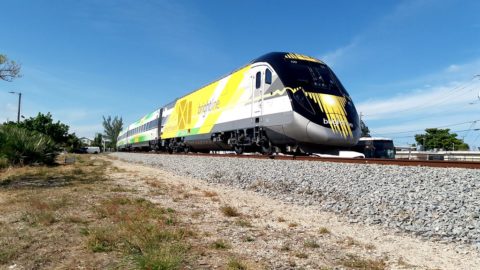In what seems like an annual ritual, the attractive-to-many (but economically non-viable) idea of putting in a high speed rail line between Toronto and Montreal is getting another airing:

The closest active model to the proposed VIA “High Frequency Rail” proposal is the Brightline service in Florida.
“BrightLine – The Return of FEC passenger service” by BBT609 is licensed under CC BY 2.0
In 2021, the Government of Canada confirmed its plans to significantly upgrade VIA Rail’s passenger rail service between the Windsor and Quebec City corridor into a high-frequency rail service.
As the name suggests, this new high-frequency rail service would offer significantly higher frequencies and reduce travel times on the route linking Toronto, Ottawa, and Montreal by 25 per cent.
With dedicated passenger rail tracks separate from freight operations, which greatly contribute to current service delays, this new train service would more consistently operate at increased speeds of up to 177 km/h to 200 km/h, and reliability would improve to an on-time performance by over 95 per cent.
This is quite true … the existing rail network between Toronto, Montreal and Ottawa was designed and built to carry freight traffic first and passengers only as a secondary goal — in many cases to attract government subsidies for the construction of the lines. Passenger services are, at best, marginally profitable but generally passenger service is a dead loss for the railways and only maintained thanks to ongoing government subsidies, grants, and tax breaks.
Freight trains — the profitable part of the railway network — have gotten longer and heavier over time as technology has improved (and train crews have gotten smaller, reducing labour costs) and the signal systems are optimized for freight traffic: long, slow-moving trains that take a lot of time and energy to speed up and slow down. Passenger trains travel faster (well, theoretically anyway) and make frequent stops to pick up and drop off passengers … signalling systems (which are critical to safe operations) need to be designed to optimize the usage pattern of the majority of the trains which in practice means freight with some modifications in high-population areas to accommodate passenger traffic.
This high-frequency rail service would use VIA Rail’s new and growing fleet of modern Siemens Venture trains operating on the Windsor-Quebec City corridor.
But as it turns out, the federal government is also contemplating a new service that is even better than high-frequency rail — the potential for a high-speed rail service, which would be the first of its kind in Canada.
Currently, the federal government is engaged in the Request For Proposal (RFP) process for the project. In July 2023, it shortlisted three private consortiums to participate in the RFP’s detailed bidding process, attracting international interest from major investors and some of the world’s largest passenger rail service operators.
This includes the consortium named Cadence, entailing CDPQ Infrastructure, AtkinsRealis (formerly known as SNC-Lavalin), Systra Canada, Keolis Canada, SNCF Voyageurs, and national flag carrier Air Canada.
The inclusion of Air Canada in the consortium is … interesting … as one of the goals of an actual high speed system would be to drain off a proportion of the short-haul passenger traffic that currently goes by air. A cynic might wonder if Air Canada’s interest in the project is to help or hinder.
According to a report in Toronto Star last week, each of the three consortiums was directed to create two detailed proposals, including one concept with trains that travel under 200 km/h and another concept with trains that travel faster than 200 km/h.
High-speed rail is generally defined as a train service that operates at speeds of at least 200 km/h.
It was further stated in the report that the new service could result in travel times of only three hours between Toronto and Montreal, as opposed to the current travel times of over five hours on existing VIA Rail services.
For further comparison, the travel time between Toronto and Montreal on flight services such as Air Canada is about 1.5 hours, which does not include the time spent at airports, while the driving time over this distance of over 1,000 km is about 5.5 hours — similar to VIA Rail’s existing services.
The potential holds for VIA Rail’s new service to operate at speeds over 200 km/h along select segments of the corridor.
The required costs to implement 200km/h speeds will be in eliminating as many grade crossings as possible and reconstructing some tight curves to allow the higher speed trains … and, as mentioned earlier, retrofitting the signal system for the faster passenger trains. Even those measures, which don’t really produce a true “high speed” system will be very expensive.




